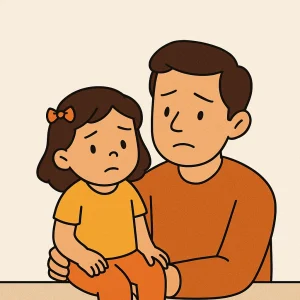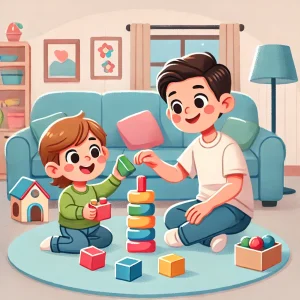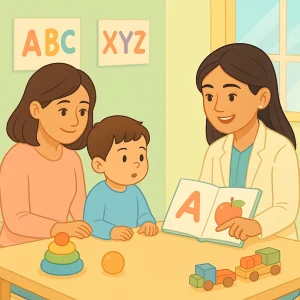Understanding and Supporting Nonverbal Children with Autism
By Rajini D
Last Updated: March 5, 2024
Autism Spectrum Disorder (ASD) is a complex developmental condition that presents challenges in social interaction, communication, and behavior. Affecting approximately 1 in 54 children, ASD’s impact is widespread, yet each individual’s experience is unique. One of the most profound challenges for many children with ASD is difficulty with speech and language development.
It’s estimated that a significant proportion of children on the autism spectrum struggle with verbal communication. Some may be entirely nonverbal, unable to use speech to express themselves, while others might have limited verbal abilities. This variance in communication can significantly impact a child’s social interactions, learning, and overall quality of life.
For more info on The Crucial Role of Parents in Online Speech Therapy
Understanding Nonverbal Autism
Nonverbal autism, often referred to as “non-speaking autism,” is a facet of Autism Spectrum Disorder where a child faces significant challenges in verbal communication. This doesn’t necessarily mean a complete absence of speech; rather, it encompasses a wide spectrum from limited speech—phrases or words used sporadically and not for regular communication—to a complete lack of spoken language.
Children with nonverbal autism often express themselves through alternative forms of communication. These can include gestures, facial expressions, or using assistive technology. It’s essential to understand that being nonverbal doesn’t equate to an absence of communication desire or ability. These children may still engage, share emotions, and express their needs in various ways.
One common characteristic of nonverbal children with autism is difficulty in social interactions. The natural flow of conversation – understanding cues, taking turns speaking, and interpreting tone – can be challenging. Additionally, sensory sensitivities common in autism can further complicate verbal communication. Overwhelming environmental factors like noise or visual stimuli might make it hard for them to focus on speech.
Also Read: Communication Difficulties in Children
The Importance of Early Intervention
Early intervention is a critical component in supporting speech and language development. Detecting and addressing communication challenges early on can profoundly impact a child’s ability to develop effective communication methods.
The stages of language development in children with autism vary widely, but with the right support, many can make considerable progress. Early interventions often focus on enhancing nonverbal communication skills first, such as pointing, making eye contact, or using picture cards. These skills lay a foundation for speech development later on.
Know more about Early Identification/ Warning Signs in child development
Communication Strategies
When it comes to supporting nonverbal children with autism, various communication strategies can be incredibly effective. These strategies are not just about teaching speech but also about enhancing overall communication skills.
One popular method is the use of sign language. American Sign Language (ASL) or Makaton, a language program using signs and symbols, can be great tools. For instance, you can start by teaching simple signs for everyday items or needs like ‘eat’, ‘drink’, or ‘sleep’. This not only aids in communication but also reduces frustration for children who struggle to express their basic needs.
Another widely used strategy is the Picture Exchange Communication System (PECS). This system involves using pictures to help children communicate. You can start by introducing pictures of favorite foods or toys, and as your child becomes familiar with these, gradually expand to include other items and emotions. PECS is a powerful tool in the non-verbal autism communication strategies toolkit, allowing children to initiate communication and express themselves.
Visual cues are also essential. These can include flashcards, visual schedules, or storyboards. For example, a visual daily schedule can help your child understand the sequence of daily activities, providing a sense of structure and predictability.
Learn more about Alternative Solutions for Nonverbal Children
Engaging in Interactive Play
Play is a natural way for children to learn, and it can be particularly beneficial in language development for nonverbal autistic children. Interactive play creates enjoyable opportunities for communication and language learning.
Simple activities like blowing bubbles can encourage nonverbal children to make eye contact or reach out, which are foundational communication skills. Narrating play activities, like describing actions while playing with toy cars (‘car goes fast’), helps in building vocabulary. This approach integrates learning into fun activities, which can be more engaging for children.
Incorporating sensory play can also be effective. Activities like playing with playdough or sensory bins can encourage expressive gestures and sounds, laying the groundwork for speech development. For instance, you might encourage your child to press the playdough and say ‘push’ or ‘squish’ to associate the action with the word.
Remember, the goal of these play activities isn’t just to teach specific words but to create an interactive and responsive environment where language can naturally develop. By integrating these playful ways to build vocabulary in nonverbal children, you can turn playtime into a rich opportunity for language development.
Read more about Integrated Yoga Therapy for teaching Toothbrushing skills | Children with ASD
Creating a Supportive Environment at Home
Creating a communication-rich environment at home is crucial for supporting the speech and language development of children with autism. Parents can play a pivotal role in this by integrating simple, effective strategies into their daily routines.
- Incorporate Visual Aids: Using visuals is a powerful way to encourage speech and understanding in children with autism. This can include visual schedules, which outline the day’s activities, or flashcards for common items and activities. Visual aids can provide a sense of structure and predictability, which is comforting for many children with autism.
- Narrate Daily Activities: Turn everyday tasks into opportunities for learning. For instance, while preparing a meal, you could describe each step in simple language, like “I am cutting carrots.” This continuous exposure to language in a natural setting can help your child associate words with actions and objects.
- Create Interactive Spaces: Dedicate areas in your home for interactive play and learning. This could be a corner with sensory toys, a reading nook, or a space for arts and crafts. The key is to create an engaging and safe environment that invites exploration and communication.
- Use Technology: With the advancement of technology, there are numerous apps and tools designed to aid speech development in children with autism. At Wellness Hub, we often guide parents toward suitable applications that can supplement traditional speech therapy at home.
- Consistency and Routine: Children with autism often thrive on routine. Establishing a consistent daily schedule that includes time for learning, play, and relaxation can create a stable environment conducive to learning and development.
Explore our related article on Engaging Home-Based Occupational Therapy Activities for Children with Autism.
Technology and Tools
Technology plays a significant role in supporting nonverbal children with autism. Various tools and applications can enhance communication skills and offer alternative ways for expression.
- Augmentative and Alternative Communication (AAC) Devices: These devices can range from simple picture boards to sophisticated speech-generating devices. They provide a voice for nonverbal children and can be customized to meet individual needs.
- Educational Apps: There are numerous apps designed to improve communication and language skills. These apps often use engaging, interactive formats to teach vocabulary, sentence structure, and conversation skills.
- Speech Therapy Apps: Specifically designed to support speech development, these apps can be used as part of a structured therapy program. They often include exercises to improve articulation, phonation, and fluency.
- Sensory Integration Tools: Apps and devices that provide sensory feedback can be particularly beneficial for children with sensory processing challenges, a common aspect of autism. These tools can aid in focus and relaxation, creating a better environment for learning and communication.
Technology and Tools for Supporting Nonverbal Autism
| Tool/Technology Type | Purpose | Examples and Usage Tips |
|---|---|---|
| AAC Devices | Alternative Communication | – Devices such as speech-generating machines can be used for children who are nonverbal. – They can be tailored to fit individual needs and preferences, including voice, language, and access method. – Ideal for expressing basic needs, emotions, making choices, and participating in conversations. |
| Educational Apps | Enhancing Language Skills | – Apps designed to teach vocabulary, sentence structure, and basic communication skills. – Look for apps that are interactive, providing engaging learning experiences through games, stories, and quizzes. – Recommended to use in short, regular sessions to build and reinforce language skills consistently. |
| Speech Therapy Apps | Speech Development | – These apps provide exercises focused on articulation, phonetics, and fluency. – Many apps offer personalized practice routines and the ability to track and monitor progress over time. – Suitable for regular practice at home, complementing traditional speech therapy sessions. |
| Sensory Integration Tools | Managing Sensory Challenges | – Tools such as weighted blankets, fidget toys, or sensory mats can help manage sensory overload and improve focus. – Useful in creating a calming environment for children who are easily overwhelmed by sensory stimuli. – Can be integrated into daily activities, learning sessions, or therapy to enhance concentration and participation. |
| Visual Aids | Structure and Routine | – Use visual aids like picture cards and visual schedules to provide structure and predictability. – Helpful in teaching new tasks, transitioning between activities, and reducing anxiety associated with change. – Can be used to reinforce routines, illustrate step-by-step instructions, and support understanding of daily schedules. |
Also Read: Unlocking Communication: Effective Speech Therapy for Autism
Overcoming Challenges
Parenting a child with nonverbal autism presents unique challenges, but with patience, understanding, and the right strategies, these hurdles can be navigated successfully.
- Managing Sensory Overload: Many children with autism experience sensory overload, where everyday sensory inputs like lights or sounds become overwhelmingly intense. This can significantly impact their ability to focus and communicate. To manage this, create a sensory-friendly environment at home. This could involve reducing harsh lighting, minimizing noise, or creating a quiet, safe space where your child can relax and feel secure. Sensory toys that provide gentle, engaging stimulation can also be helpful.
- Encouraging Expression in Nonverbal Children: Expression isn’t limited to words. Encourage your child to express their needs, emotions, and responses through gestures, sign language, or AAC devices. Celebrate all forms of communication, be it a sound, a gesture, or a look. Remember, every small step towards expression is progress.
- Dealing with Frustrations and Setbacks: It’s natural for both you and your child to feel frustrated at times. When communication attempts don’t go as planned, take a step back and give both of you a break. Consistency is key, but so is flexibility. Be willing to try different approaches and find what works best for your child.
- Building a Support Network: Connect with other parents, therapists, and specialists who can provide advice and support. Wellness Hub offers resources and a community where you can share experiences and learn from others facing similar challenges.
- Celebrating Small Victories: Every new word, gesture, or form of communication is a victory. Celebrate these moments to encourage your child and remind yourself of the progress being made.
- Educational Support: Work closely with your child’s educators to ensure their learning environment is tailored to their needs. This might include individualized learning plans or specific accommodations to help them thrive.
- Professional Guidance: Regular consultations with speech therapists, occupational therapists, and psychologists can provide valuable insights and strategies tailored to your child’s needs.
Also Read: What are the Tips for Parenting an Autistic Child? | Helping Your Child with Autism
Overcoming Common Challenges
| Challenge | Solution | Tips and Details |
|---|---|---|
| Sensory Overload | Create a Sensory-Friendly Environment | – Use dim lights to reduce visual stimulation. – Minimize noise or use soothing background sounds. – Provide a quiet, safe space or sensory corner for relaxation. |
| Frustration in Communication | Encourage Nonverbal Expression | – Use gestures like pointing or waving to aid communication. – Introduce drawings or picture cards for expression. – Implement AAC devices for more complex communication needs. |
| Behavioral Issues | Consistent Routine | – Establish a clear, predictable daily schedule. – Use visual aids like charts or color-coded calendars to illustrate the day’s activities. – Ensure transitions between activities are smooth and well-communicated. |
| Social Interaction | Engage in Group Activities | – Participate in playgroups to encourage social skills. – Attend therapy sessions that focus on social interaction. – Involve in activities like team sports or group arts and crafts, tailored to the child’s comfort level. |
Conclusion
As we conclude this journey through understanding and supporting speech in nonverbal children with Autism Spectrum Disorder, it’s important to reflect on the key insights we’ve explored. Every child with autism is unique, and their path to communication will be just as individual. Embracing this uniqueness is crucial – there’s no one-size-fits-all solution but a spectrum of strategies that can be tailored to each child’s specific needs.
We discussed the importance of early intervention, the effectiveness of communication strategies like sign language, PECS, and using visual cues, and the vital role of engaging in interactive play. Creating a supportive environment at home and utilizing technology and tools can offer significant benefits. And, of course, facing and overcoming the challenges along the way is part of this journey.
For parents and caregivers navigating this path, remember that patience, love, and persistence are your greatest strengths. Each small step forward is a triumph, a testament to your dedication and your child’s resilience. The road might be long and sometimes challenging, but you are not alone. Wellness Hub is here as a supportive resource, offering guidance, information, and a community where you can find understanding and support.
Frequently Asked Questions:
1. What are the first steps to take when supporting speech in a nonverbal autistic child?
The first steps include consulting with healthcare professionals like pediatricians and speech therapists, understanding your child’s unique needs, and introducing communication strategies like sign language, PECS, or visual cues.
2. Can nonverbal autistic children develop speech over time?
Yes, many nonverbal autistic children can develop speech abilities over time, especially with early intervention, consistent speech therapy, and supportive communication environments at home.
3. How can I create a communication-friendly environment at home for my nonverbal autistic child?
Create a communication-friendly environment by using visual aids, engaging in interactive play, establishing routines, and incorporating technology like speech therapy apps and AAC devices.
4. Are there specific play activities that encourage speech development in nonverbal autistic children?
Yes, play activities like sensory play, pretend play, and interactive games that encourage gestures, eye contact, and turn-taking can be beneficial for speech development.
5. How does technology aid in supporting nonverbal autistic children?
Technology aids through educational apps, AAC devices, and speech therapy tools that offer alternative communication methods and enhance language learning.
6. What challenges might parents face when supporting a nonverbal autistic child’s speech, and how can they be overcome?
Common challenges include managing sensory overload, dealing with frustrations, and finding effective communication methods. Overcoming these challenges involves creating a supportive environment, being patient, and seeking professional guidance.
7. Are there any online resources or communities for parents of nonverbal autistic children?
Yes, there are online resources and communities, such as Wellness Hub, where parents can find information, support, and connect with others facing similar challenges.
8. Can alternative communication methods hinder the development of verbal speech in autistic children?
No, alternative communication methods like sign language or AAC devices do not hinder verbal speech development. In fact, they often provide a foundation for developing speech skills.
9. How important is early intervention in developing speech in nonverbal autistic children?
Early intervention is crucial as it significantly improves the chances of developing communication skills. It should ideally begin as soon as a delay in speech is noticed.
10. What role do speech therapists play in helping nonverbal autistic children develop speech?
Speech therapists play a vital role by assessing the child’s specific needs, developing personalized therapy plans, and providing targeted exercises and strategies to enhance communication skills.
About the Author:
Rajini Darugupally
M.Sc., Speech-Language Pathologist (9+ years of experience)
Rajini is a passionate and dedicated Speech-Language Pathologist with over 9+ years of experience, specializing in both developmental speech and language disorders in children and rehabilitation in adults. Driven by a desire to empower each individual to find their voice, Rajini brings a wealth of experience and a warm, genuine approach to therapy.
Currently, at Wellness Hub, she thrives in a team environment that values innovation, compassion, and achieving results for their clients.
Connect with Rajini to learn more about how she can help you or your loved one find their voice.
Book your Free Consultation Today
Parent/Caregiver Info:
Client’s Details:
* Error Message









